15 Best Places and Beaches to Visit in the Region of Murcia
From hip bars and restaurants to secluded natural coves, get ready to discover the gorgeous places and beaches of Murcia.
If you’re looking for fabulous weather, the Region of Murcia is a top destination. Sunbathers will be pleased to know that in some years, it’s possible to catch some rays as early as March.
While parts of Spain in the north might be hit by snow, deluges of rain and strong winds, other areas, mainly in the southern half of the peninsula, can be basked in glorious sunshine and unexpectedly high temperatures. This means that beaches become busy fairly quickly. During public holidays and the summer break, many of Spain’s beaches look pretty full.
The Costa del Sol and the Costa Blanca are popular choices for most visitors, but the neighboring areas are also worth visiting. Although less well-known, Murcia’s beaches are also stunning. In fact, if you’re looking for hidden coves and fewer tourists, these beaches might be just what you need.
1.Roman Theatre of Cartagena (Teatro Romano de Cartagena)

Roman Theatre of Cartagena (Teatro Romano de Cartagena)
Built between the 5th and 1st centuries BC, Cartagena’s Roman Theater wasn’t discovered during modern times until 1988, following which a massive restoration took place. Come 2008, the newly discovered theater was opened to the public along with a museum, once again inviting visitors into a grand space that, during Roman times, welcomed some 6,000 spectators.
The theater is situated on a vista-rich city hillside, from which the stadium seating was carved out of the actual rock below. During a visit, you can explore the different corners of this conserved space, as well as check out the museum, which offers an in-depth overview of the archeological remains along with informative panels explaining the restoration (all in both English and Spanish).
2.Punic Wall

Punic Wall
Fans of distant history will relish in discovering Cartagena’s Punic Wall, which dates back to the 3rd century BC. To explore its remains, head to the Punic Wall Interpretation Center, where you can not only see a portion of the salvaged structure (which is protected within the center) but also learn about its storied past.
The wall, of which 30 meters have been excavated, served as a city-surrounding defensive fortification built by the Carthaginians. The goal was to protect against Roman attack during the Second Punic War (though it ultimately failed). Apart from viewing the wall, you can also get up close to a later crypt, and learn more about it all via the center’s informative video and display boards. While the museum and archeological remains are rather small in size, the history is big, making it an intriguing visit for those keen to learn more about these ancient times.
3.Calle Mayor

Calle Mayor
To soak in the essence of Cartagena, plan to take a stroll down its Calle Mayor, or Main Street. The pedestrian-only avenue is the place to go to appreciate the city’s architecture, go shopping, or even to sit at a restaurant’s outdoor terrace as you watch the world go by.
Just steps away from the port and sea, the street begins at the grand, palm tree-lined Plaza de Ayuntamiento, or Town Hall Square, home to none other than the giant palace that is Town Hall itself. From there, travel past (or stop at) the Roman Theater Museum and onto Calle Mayor with its marble-tiled promenade. Along the way, you’ll walk by noteworthy architecture such as Art Nouveau masterpieces Casino de Cartagena, a fancy 19th-century social club, and Cervantes House (not to be confused by the famous author; this building was named after a wealthy businessman).
4.Murcia Cathedral (Catedral de Murcia)

Murcia Cathedral (Catedral de Murcia)
To see and experience Murcia’s cathedral is a true feast for the eyes and senses. Its exterior is a vision of Baroque and Renaissance styles, with a bell tower that literally towers 95 meters over the city. The soaring structure houses 25 bells, each with their own name, and which have, in times past, together served to warn of various events from floods to wars and celebrations.
Built starting in 1394 on the site of a former mosque, the church is a mish-mash of styles given that its growth continued until the 18th century. Its Gothic interior is no less impressive than the exterior, featuring 23 different chapels — the most notable of them is Los Velez with its magnificent, star-shaped vaulted ceiling. The cathedral is also home to a museum, where you can discover a range of religious artifacts, as well as spy the excavated remains of the former mosque.
5.Royal Casino of Murcia (Real Casino de Murcia)
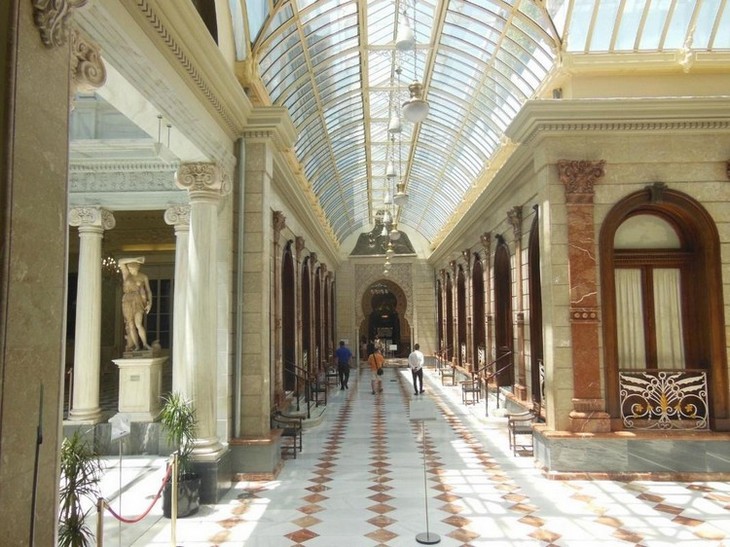
Royal Casino of Murcia (Real Casino de Murcia)
The Royal Casino of Murcia (Real Casino de Murcia) is an extravagant architectural relic from the late 19th century, and features quite an eclectic mixture of design styles — from Modernist to Neonazari — that together are nothing short of dazzling. Located in the city’s old quarter, and just steps away from the main cathedral, the casino is a must-do stop on any Murcia itinerary.
Though a private social club, the recently restored building is open for tourist visits and events. While there, you can explore its many rooms and halls, including the Arabic patio, noted for its iron and glass dome; the lavish dance hall complete with paintings, gilt detailing, and giant, sparkling chandeliers; and the main gallery, a covered passageway illuminated by light that pours in from the windowed ceiling. More rooms and opulent corners abound, from the luxurious ladies’ room to the glamorous, wooden-shelved library.
6.Terra Natura Murcia

Terra Natura Murcia
Explore the wilds of both the African Savanna and the Iberian Peninsula at Terra Natura Murcia, a ‘zooimmersion’ park that is home to over 500 animals. You can see several endangered species, such as the white rhino, ring-tailed lemurs, and Masai giraffes, before learning about the animals and lunching at the onsite restaurant.
7. Playa de Poniente – Águilas

Playa de Poniente
This urban beach is one of the most popular in the region of Murcia. It has a great number of services and is particularly popular with families who visit the tourist resort of Águilas. For most of the year, parking is not a problem; there are lots of residential roads surrounding the beach where you can leave your car. However, it gets very busy in July and August, when it feels like the entire country as arrived. If you choose to travel by public transport, expect to walk about 1.5 kilometers from the bus stop in town.
The beach is just over 1km in length and some 40m wide in most parts. The sand is fine and golden, although there are a few areas with loose stones. The Poniente beach, with its gentle slope into the sea, sits between the Casica Verde and the La Colonia breakwater.
8. Percheles – Mazarrón
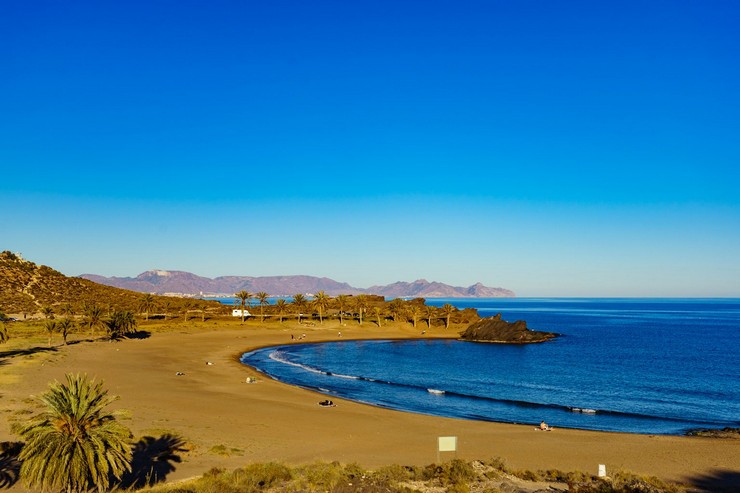
Percheles Beach
Percheles Beach in Murcia is a very peaceful location with plenty going for it, despite its lack of services. The beach itself is full of palm trees and sand dunes – there are no high-rise hotels or gaudy bars lining the seafront. In fact, it’s the perfect place to visit if all you want to see is sea, sand, and blue sky. The golden sand is very fine and the sea is generally calm. Percheles Beach is actually a fan-shaped cove, measuring just under 300m long and 84m wide. This is a great place to relax, unwind, and forget about the chaos of life.
9.Playa de las Palmeras
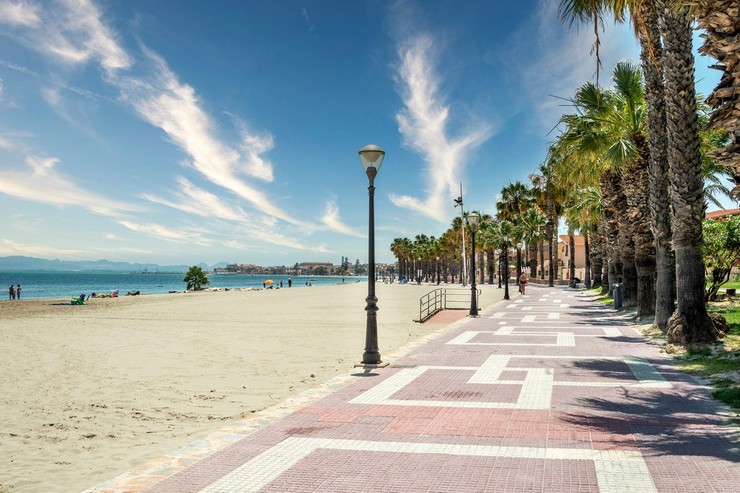
Playa de las Palmeras
Playa de las Palmeras is located in the area of Los Alcázares. It’s approximately 1km long and 30m wide. It is within an urban area, with houses just behind the beach. Don’t let the color of the sand put you off – it might be grey, but it’s also very fine and soft. This stunning beach attracts a lot of visitors, and fills up in the summer. When it comes to amenities, Playa de las Palmeras has it all: from bars and restaurants to sunbed hires and showers.
10.Cala Cortina – Cartagena
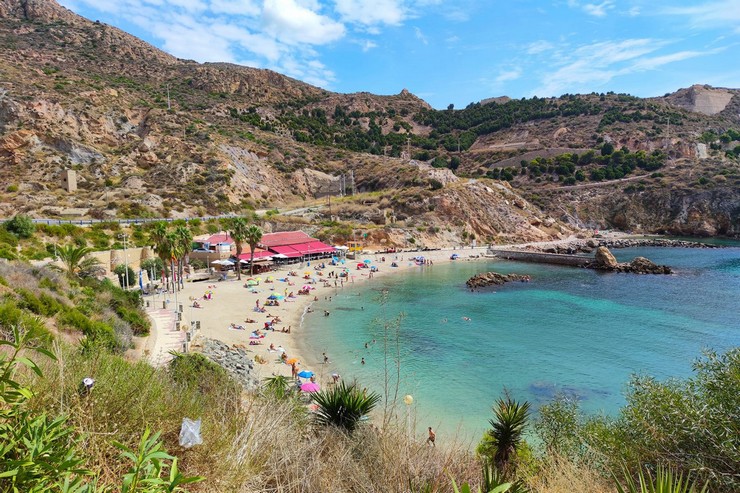
Cala Cortina beach
Cala Cortina is a gorgeous little horseshoe-shaped cove that gets busy with the locals at the height of summer. The sandy beach sits between several which makes it a great area for snorkeling. To access the beach, you pass through a tunnel at the Puerto de Santa Lucía. There are a good number of services including a children’s play area and an excellent bar and restaurant with some of the best seafood dishes in Spain.
11.La Azohía – Cartagena
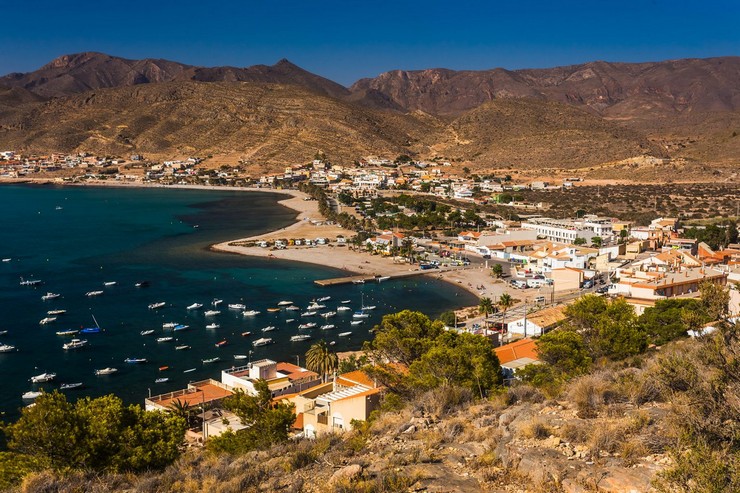
La Azohía
La Azohía is home to another of Murcia’s urban beaches. Although it gets busy during the summer months, this fishing village on the Costa Cálida retains its enchanting quality. The beach itself is only 800m long and 8m wide, but it’s an idyllic setting. Indeed, its palm trees almost make you feel like you’re in the Caribbean. And just like in tropical climes, the water in La Azohía is also crystal clear and warm. This beach also provides visitors with numerous amenities and is therefore popular with families with young children.
12.La Carolina – Águilas
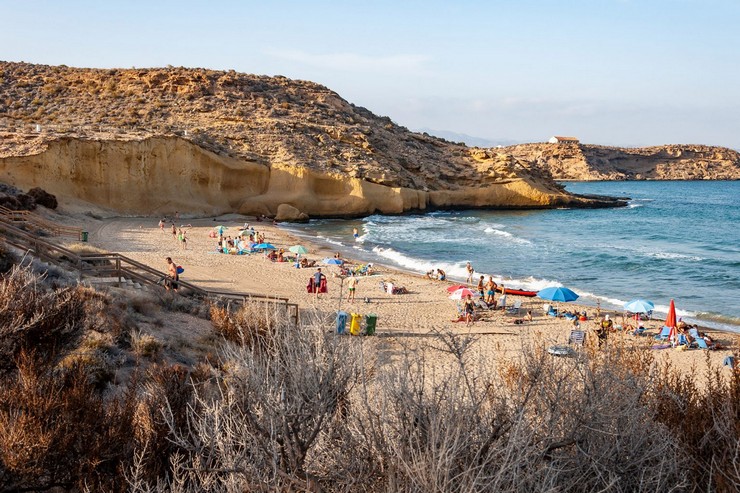
La Carolina beach
The Playa de la Carolina, or de los Ingleses as some call it, is an extraordinary beach. Not far from Águilas, it’s pleasant on a windy day, as the surrounding rocks and dunes provide a natural barrier from the wind. The water is very warm – almost like taking a bath. Apart from a bar and a restaurant, there are very few facilities. Nevertheless, this is still one of the prettiest small beaches on this stretch of Murcia.
13. Playa de Paraíso – Cartagena
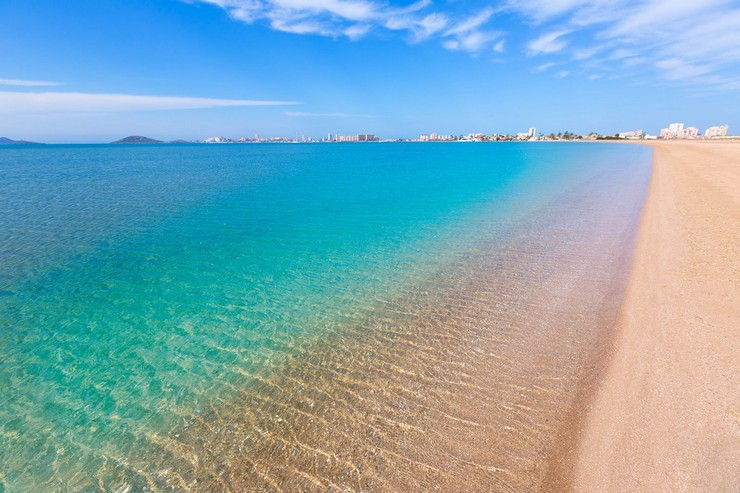
Playa de Paraíso
The Playa de Paraíso is a beautiful stretch of fine, golden sandy beach, with clear water that is shallow right up to 100m out to sea. It is on the Mar Menor, an area of warm salty water which is said to have healing properties. Close to the salt lakes, this beach and the water around it apparently help those suffering from arthritic joints, inflammation, and skin complaints. This beach is excellent for families and offers a host of services, including plenty of water-sports and places to eat and drink.
14.Playas de Calblanque – Cartagena
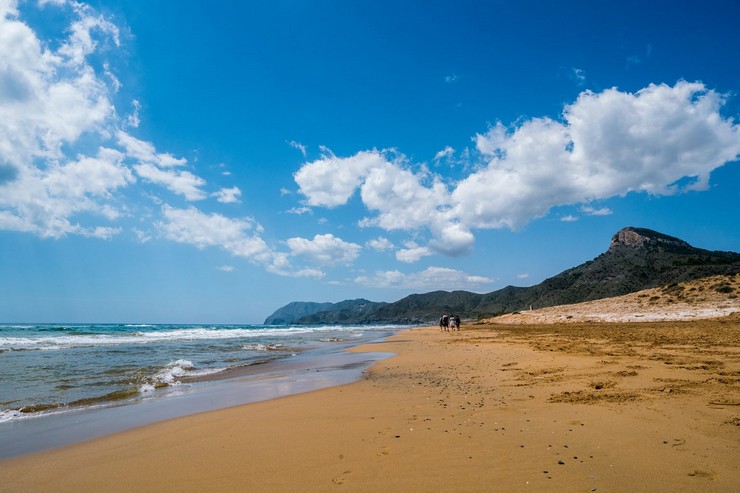
Playas de Calblanque
The beaches in the Calblanque Regional Park are havens of tranquility, as they are part of a protected area, and there are limits to the number of visitors. Black rocks surround the fine sandy beaches, and the vegetation is similar to that of a desert. These are great for diving or snorkeling, thanks to the rocky areas. Some of the beaches have nudist areas, so check beforehand if that’s not your thing.
15. Playa de los Cocederos del Hornillo – Águilas
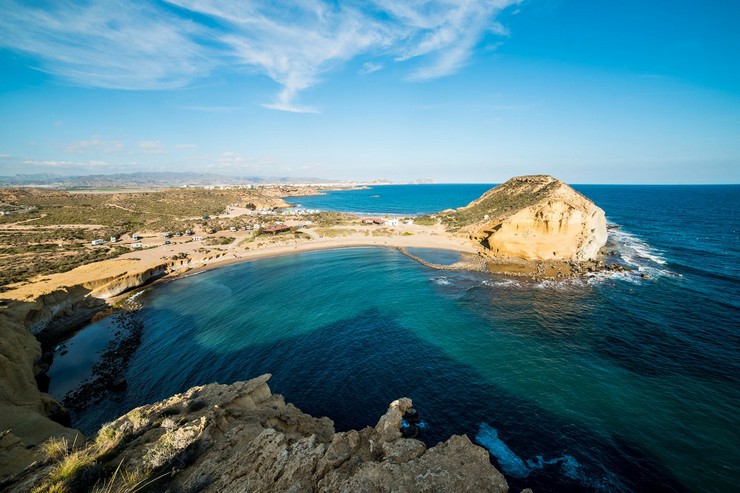
Playa de los Cocederos del Hornillo
This spectacular, remote little cove is only 150m long with 25m of golden sand. The water is bright turquoise and very shallow. While the beach isn’t overcrowded, people take the trouble to drive down the dusty lane to the car park just 50m from the sand. The area is sheltered from the wind and the waves, making it peaceful and calm. What’s exciting about this place is that the surrounding rocks are all full of natural caves that used to be inhabited during the summer or used as shelter from the weather by fishermen. Despite its remoteness, there is a bar nearby and a few other services.